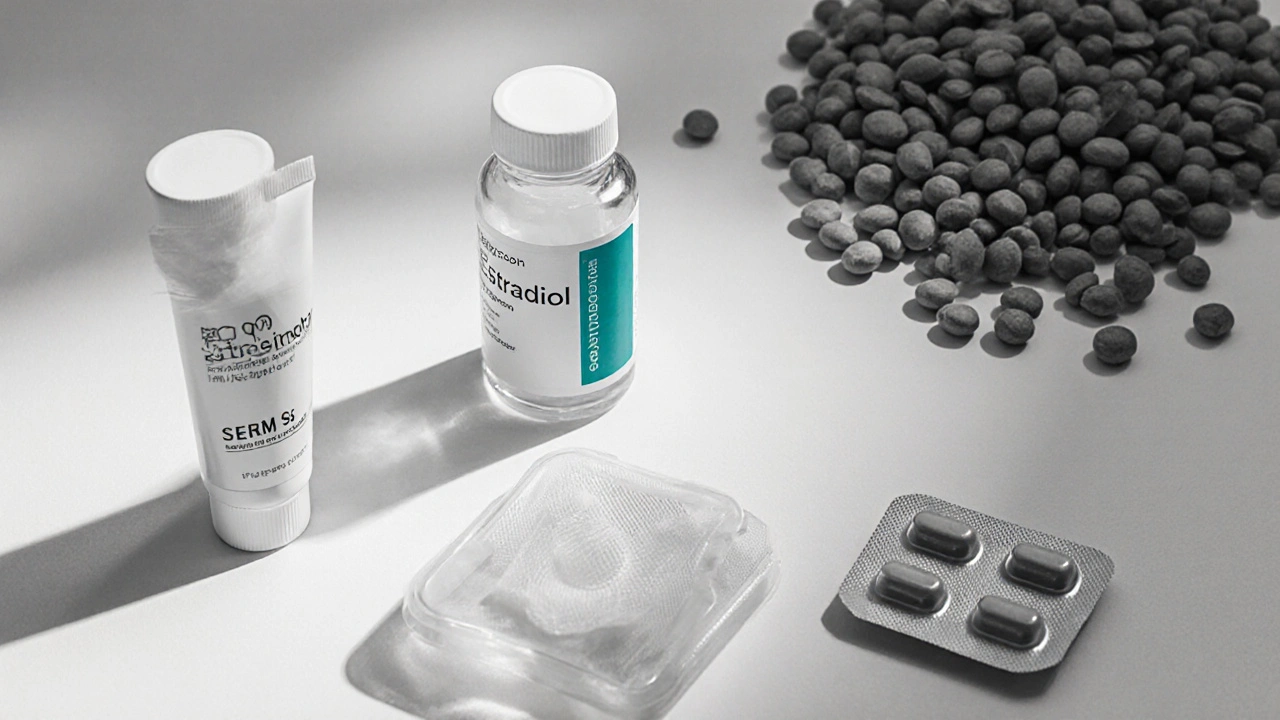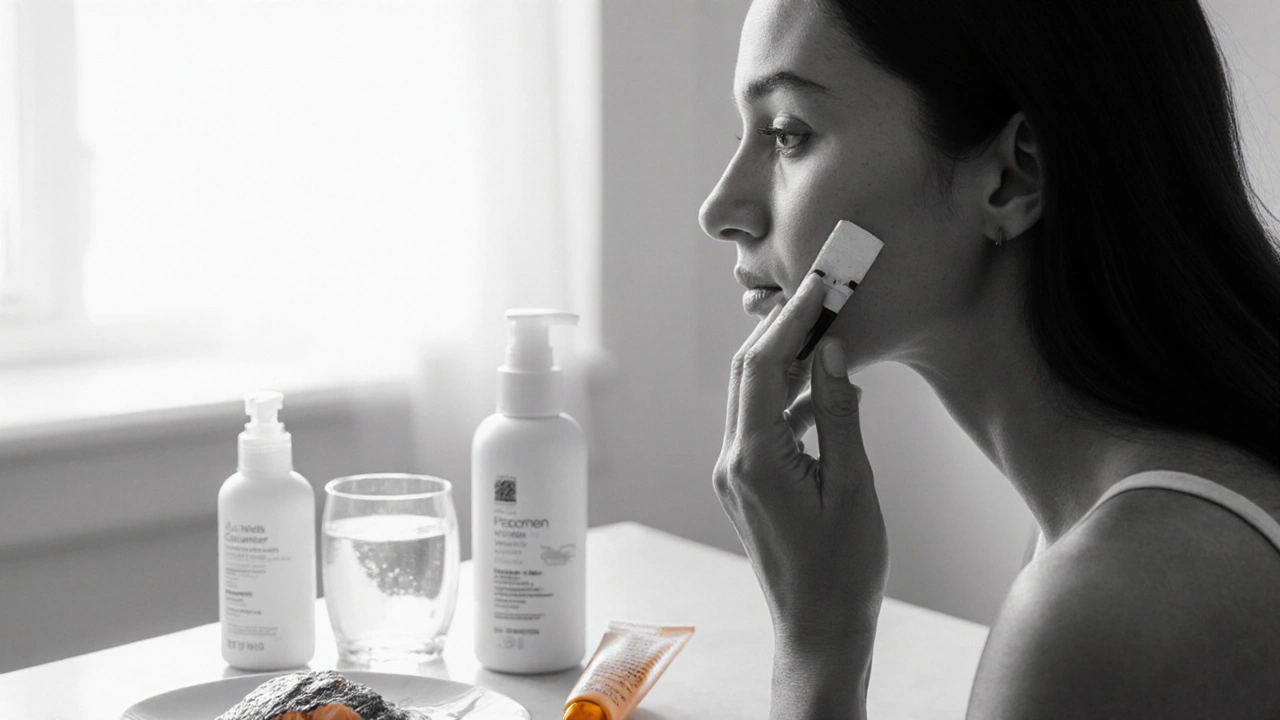Estrogen Therapy Recommender
Find Your Best Hormonal Therapy Option
Answer these questions to get personalized recommendations based on your symptoms and health profile.
Your Recommendations
Important Note
This tool provides general guidance based on your input. Always consult with your healthcare provider before starting any hormonal therapy.
When estrogen levels dip, many people notice that their skin feels tight, flaky, and just plain uncomfortable. The itching that comes with that dryness isn’t just annoying-it’s a sign that the skin barrier is struggling. hormonal therapy can jump‑start the skin’s ability to retain moisture and calm irritation, but it works best when you understand why estrogen matters, what treatment options exist, and how to pair them with everyday skin care.
Why Estrogen Matters for Healthy Skin
Estrogen is more than a reproductive hormone; it’s a key regulator of skin structure. Estrogen is a steroid hormone that binds to receptors in the epidermis and dermis, boosting collagen synthesis, increasing water‑binding molecules like hyaluronic acid, and supporting the production of natural oils (sebum) that keep the skin supple. When those receptors get fewer signals, the skin loses elasticity, thins, and becomes prone to transepidermal water loss (TEWL). That’s why post‑menopausal women, people on certain cancer treatments, or anyone with low estrogen often report dry, itchy skin.
How Low Estrogen Leads to Dryness and Itching
Three main mechanisms drive the symptoms:
- Reduced Sebum Production - Less oil means the skin’s surface film evaporates faster, leaving a dry feel.
- Weakened Barrier Lipids - Estrogen helps maintain ceramides and cholesterol in the stratum corneum. Without enough, the barrier cracks and lets irritants in.
- Decreased Collagen and Elastin - The skin becomes thinner, so even mild friction or temperature changes trigger itching.
These changes are measurable. A 2023 study in the Journal of Dermatological Science found that women aged 55‑65 with low serum estradiol had a 35% higher TEWL rate than age‑matched controls, correlating directly with self‑reported itch intensity.
Hormonal Therapy Options for Skin Health
Not all hormonal treatments are created equal. Below is a quick snapshot of the most common approaches, how they’re delivered, and what to expect for skin benefits.
| Therapy | Route | Typical Dose | Skin Benefits | Main Drawbacks |
|---|---|---|---|---|
| Oral Estradiol | Tablet | 0.5-2mg daily | Systemic estrogen restores barrier lipids; improves overall hydration | Potential increased clot risk; liver metabolism |
| Transdermal Patch | Skin patch | 0.025-0.05mg/hr | Steady delivery bypasses liver; good for sensitive skin | Patch irritation in some users |
| Estradiol Cream | Topical | 0.5-1% applied twice daily | Directly targets local skin; quickly boosts moisture | Limited systemic effect; may need higher frequency |
| Selective Estrogen Receptor Modulators (SERMs) | Oral | 20-60mg daily (tamoxifen, raloxifene) | Mixed agonist/antagonist effects; can help bone health but less impact on skin | Can cause hot flashes; less direct skin benefit |
| Phytoestrogen Supplements | Oral (plant‑based) | 30-80mg isoflavones | Gentle estrogenic activity; may improve hydration modestly | Variable potency; may interfere with thyroid meds |
Choosing the right option depends on personal health history, how severe the skin symptoms are, and whether you need systemic benefits (like bone protection) in addition to skin improvement.

Integrating Hormonal Therapy with Everyday Skincare
Even the best hormone regimen won’t fix dry skin if you neglect basic skin care. Here’s a practical routine that works hand‑in‑hand with therapy:
- Gentle Cleanser - Choose a sulfate‑free, pH‑balanced cleanser. Over‑cleansing strips natural oils and worsens TEWL.
- Barrier‑Repair Moisturizer - Look for products containing ceramides, cholesterol, and hyaluronic acid. Moisturizer is a topical formulation that helps lock in water and replenish skin lipids. Apply while skin is still damp to seal in moisture.
- Targeted Estrogen Cream - If you’re on a prescription estrogen cream, apply a thin layer to the most affected areas after your moisturizer. This layered approach maximizes both barrier repair and estrogen delivery.
- Sun Protection - UV accelerates collagen breakdown. Use a broad‑spectrum SPF30 or higher daily.
- Hydration from Inside - Drink water, eat omega‑3‑rich foods (salmon, flaxseed), and consider a modest supplement of vitaminE, which supports skin barrier function.
Potential Risks and How to Mitigate Them
Hormonal therapy isn’t risk‑free. The most common concerns include:
- Blood Clots - Oral estrogen raises clot risk, especially in smokers or those with clotting disorders. Transdermal or topical routes carry less risk.
- Breast Tissue Stimulation - Systemic estrogen can modestly increase breast density. Regular mammograms are essential.
- Skin Irritation - Some people develop contact dermatitis from patches or creams. Switch to a hypoallergenic formulation if needed.
Before starting any regimen, schedule a baseline check‑up. Labs should include estradiol level, complete blood count, and lipid panel. Your doctor can tailor the dose to balance skin relief with overall health safety.

When to Seek Professional Help
If you notice any of these red flags, it’s time to see a specialist:
- Persistent itching that wakes you up at night.
- Visible skin cracks, especially around elbows or knees.
- New rash or swelling after applying a hormone product.
- Breast changes, unusual bleeding, or unexplained weight loss.
A Dermatologist is a physician who specializes in skin, hair, and nail disorders. They can run a skin‑strip test, adjust your topical regimen, or recommend a different hormonal approach.
Quick Checklist for Managing Estrogen‑Related Skin Issues
- Get a serum estradiol test to confirm low levels.
- Discuss therapy options with your primary care provider or endocrinologist.
- Choose the delivery method that fits your lifestyle and risk profile.
- Pair therapy with a barrier‑repair moisturizer and gentle cleanser.
- Apply sunscreen daily and stay hydrated.
- Schedule follow‑up labs every 6‑12 months.
- Contact a dermatologist if symptoms persist or worsen.
Frequently Asked Questions
Can over‑the‑counter moisturizers replace hormonal therapy?
Moisturizers are essential, but they only address the surface barrier. Hormonal therapy tackles the root cause-low estrogen-and can restore the skin’s ability to produce its own natural oils. The best results usually come from combining both.
Is transdermal estrogen safe for people with a history of blood clots?
Transdermal delivery bypasses the liver, which means it carries a lower clot risk than oral estrogen. However, anyone with a clotting disorder should still discuss options with a hematologist before starting.
How long does it take to see skin improvements?
Most patients notice reduced dryness within 4‑6 weeks of consistent therapy. Itching may improve sooner, often within 2‑3 weeks, but full barrier restoration can take up to 3 months.
Are phytoestrogen supplements effective for skin?
Phytoestrogens provide a mild estrogenic effect and may help with mild dryness, but they’re less potent than prescription estradiol. They’re best used as adjuncts, not as a stand‑alone solution for severe symptoms.
Do SERMs help with skin hydration?
SERMs act as estrogen agonists in bone and cardiovascular tissue but often act as antagonists in skin. They’re generally not chosen for skin hydration and may even worsen dryness for some users.

 Oct, 17 2025
Oct, 17 2025

Nickolas Mark Ewald
October 17, 2025 AT 02:08Thanks for the clear overview.
I’ve tried a low‑dose oral estradiol and noticed my skin feels less tight after a few weeks.
Pairing it with a ceramide‑rich moisturizer really helps lock in the moisture.
I also keep my cleanser gentle and avoid hot showers.
Simple steps can make a big difference.
Chris Beck
October 18, 2025 AT 03:08THIS IS WHAT THEY DONT TELL YOU!! WE NEED TO STOP REACHING FOR IMPORTED PATCHES AND KEEP THINGS LOCAL!!
Rebecca Mitchell
October 19, 2025 AT 04:08Honestly i think you’re just overcomplicating a simple skin issue and should just use a good moisturizer instead of all that hormone talk.
Roberta Makaravage
October 20, 2025 AT 05:08While the passion is noted, the science says transdermal delivery bypasses first‑pass metabolism, offering steadier estrogen levels 🌿💧. Ignoring evidence in favor of nationalism undermines patient care.
Lauren Sproule
October 21, 2025 AT 06:08Hey there i totally get where you're coming from
I think the key is to start with a gentle cleanser and then add a moisturizer with ceramides if you can.
It might feel a bit weird at first but your skin will thank u later.
CHIRAG AGARWAL
October 22, 2025 AT 07:08So you say it's weird? Honestly i think most people just ignore the real issue and blame hormones for everything. The patch might be fine but why bother when a cheap cream works just as well??
genevieve gaudet
October 23, 2025 AT 08:08From a cultural perspective, skin health has always been intertwined with rites of passage and communal care.
In many societies, the use of plant‑derived estrogens was a whispered secret passed down by grandmothers.
Modern hormonal therapy, however, brings that ancient wisdom into the clinical realm with precision.
When estradiol levels dip, the barrier function of the skin falters, leading to the dry, itchy sensations described.
The body’s own production of hyaluronic acid and ceramides drops, and a simple moisturizer can only patch the surface.
By restoring estrogen, we essentially reboot the natural lipid synthesis pathways.
This biochemical cascade not only improves hydration but also supports collagen, which keeps the skin supple.
Patients often report that itching subsides within two weeks, a testament to the rapid signaling changes.
Yet, it is crucial to remember that systemic therapy carries risks, such as clotting, especially in high‑risk groups.
Therefore, the choice between oral, transdermal, or topical routes must be individualized.
In my experience, a transdermal patch offers a balanced approach, avoiding liver metabolism while delivering steady hormone levels.
Combining that with a barrier‑repair cream creates a synergistic effect, much like a duet in a traditional song.
Moreover, lifestyle factors-adequate hydration, omega‑3 intake, and sun protection-act as the supporting chorus.
When all these elements harmonize, the skin regains its resilience and the patient’s quality of life improves dramatically.
So, while the science is complex, the underlying principle remains simple: support the body’s natural architecture with thoughtful, evidence‑based interventions.
Patricia Echegaray
October 24, 2025 AT 09:08We all know the pharma giants are pushing these creams to keep us dependent, right? They hide the real cure behind a veil of red‑tape and glittering ads, making us chase pricey patches while the truth stays buried.
Miriam Rahel
October 25, 2025 AT 10:08While the article presents a comprehensive overview, it neglects to address longitudinal data regarding cardiovascular outcomes associated with chronic estrogen supplementation. A rigorous meta‑analysis would be requisite to substantiate the claimed dermatologic benefits.
Kate Marr
October 26, 2025 AT 10:08Your point is noted, yet dismissing the immediate skin relief in favor of distant statistics ignores the everyday struggles of citizens. People deserve practical solutions now 📈.
Frank Diaz
October 27, 2025 AT 11:08The skin, like the soul, reflects the internal equilibrium; when hormones waver, the outer realm screams for balance. Ignoring this dialogue is a moral failing.
Richard O'Callaghan
October 28, 2025 AT 12:08i think youre overthinking its just dry skin and a cream will fix it dont need all that philosophy
Alexis Howard
October 29, 2025 AT 13:08Well i guess the article is okay but i cant see why anyone would bother with hormones when regular moisturizers work fine
Darryl Gates
October 30, 2025 AT 14:08Your skepticism is understandable, however evidence shows that estrogen deficiency directly impacts lipid synthesis, which moisturizers alone cannot fully restore. Consider a trial of low‑dose therapy alongside your current routine for optimal results.
Katie Henry
October 31, 2025 AT 15:08It is with great enthusiasm that I encourage all individuals experiencing estrogen‑related xerosis to pursue a structured therapeutic regimen, thereby restoring cutaneous vitality and overall well‑being.
Joanna Mensch
November 1, 2025 AT 16:08One must remain cautious; hidden agendas often lurk behind seemingly benevolent medical recommendations, and independent verification is essential.